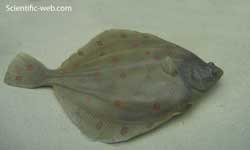European plaice, Pleuronectes platessa, are a commercially important flatfish occurring on the sandy bottoms of the European shelf. Its geographical range is from the Barents Sea to the Mediterranean. Plaice are characterised by their smooth, brown skin, red spots and bony ridge behind the eyes. It feeds on polychaetes, crustaceans and bivalves and can be found at depths up to approximately 200 m. Life cycle Plaice are determinate spawners in which fecundity is determined before the onset of spawning. Females mature, i.e. are able to spawn, at ages from 3 to 7 years old. However, in the North Sea, most females mature at 3 years. Ovary development begins around late August to September with the spawning being from December to May. Each female releases eggs in batches every 3 to 5 days for approximately 1 month. The eggs hatch after approximately two weeks and drift passively in the plankton. The larvae drift in the plankton and metamorphose after about 8 to 10 weeks, dependent on temperature, at which time they settle in the intertidal zone of sandy beaches. The larvae exhibit what is sometimes called semi-active tidal transport. As the larvae cannot swim against the prevailing currents, they make use of their ability to alter their vertical position in the water column to ensure they are transported to suitable habitat. On incoming or flood tides (water level is rising) the larvae move up into the water column and are thus transported towards land. On the outgoing or ebb tides (water level is falling), the larvae move down the water column and are not transported away from the intertidal by the tidal currents. When the larvae have reached a suitable site for settlement, the metamorphosis to the asymmetric body shape takes place. This can take up to 10 days. Recently transformed juveniles settle onto shallow intertidal beaches. The very youngest juveniles will, for a period of up to a week, strand themselves in very shallow pools on the intertidal once the tide has receded. The reasons for this behaviour are not clear. During the first year of life (when the fish are called 0+ group), the juveniles will stay in these shallow intertidal habitats for up to 7 months (depending on latitude and/or temperature), before migrating to deeper waters. Some of these fish will return the next year (when they are I+ group) and even fewer when they are II+ group, however, the majority of juveniles do not return after they have migrated during their first year. Plaice as a food Plaice is sometimes used as the fish in fish and chips, in countries where the dish is popular.[1] In North German and Danish cuisine plaice is one of the most commonly eaten fishes. Filleted, battered and pan-fried plaice is popular hot or cold as an open sandwich topping together with remoulade sauce and lemon slices. Battered plaice can also be served hot with french fries and remoulade sauce as a main dish; this fish and chips variant is commonly available as a children's special in Danish restaurants. Breaded frozen plaice, ready to be baked or fried at home, are readily available in supermarkets. Fresh plaice is also oven-baked. Plaice, along with the other major demersal fish in the North Sea such as cod, monkfish and sole, is listed by the ICES as "outside safe biological limits." Moreover, they are growing less quickly now and are rarely older than six years, whereas they can reach forty.[2] The World Wildlife Fund says that in 2006 that "of the eight plaice stocks recognised by ICES, only one is considered to be harvested sustainably while three are overexploited. Data is insufficient to assess the remaining stocks; however, landings for all stocks are at or near historical lows." [3] References
External links
Retrieved from "http://en.wikipedia.org/" |
|

